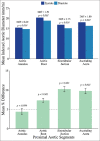Aortic size in children: Systolic measurements are different from diastolic measurements
- PMID: 34103855
- PMCID: PMC8174627
- DOI: 10.4103/apc.APC_157_19
Aortic size in children: Systolic measurements are different from diastolic measurements
Abstract
Background: Current guidelines recommended aortic measurements during diastole in adults and during systole in children. Recent studies in adults have demonstrated noteworthy differences in aortic measurements during systole and diastole in the same subjects. In the present study, we aimed to characterize systolic and diastolic differences in aortic measurements in healthy children.
Materials and methods: This retrospective study included 272 children who had a complete echocardiogram and no heart disease. Aortic measurements at the annulus (ANN), aortic root (AOR), sinotubular junction (STJ), and ascending aorta (AAO) were performed. Systolic and diastolic values were compared by calculating the mean systolic to diastolic (SD) percent difference for each segment; if the SD difference was >5%, it was considered clinically important. Similar measurements were conducted by another observer in 18% of the subjects.
Results: Systolic measurements were larger than diastolic measurements with mean SD percent differences >5% (P < 0.001) for the AOR (7.3% ± 5.5%), STJ (10.24% ± 7.1%), and AAO (9.8% ± 7.4%). There was no clinically significant SD difference for the ANN. There was an excellent intraclass correlation coefficient between observers (0.982-0.995).
Conclusions: Systolic measurements for the AOR, STJ, and AAO were larger than diastolic measurements. Normal reference values are utilized to design treatment for patients with abnormal aortic sizes, and the timing in the cardiovascular cycle used to decide the reference values should be equivalent to the timing used to make measurements in clinical practice. This is particularly imperative as patients transition their care from a pediatric to an adult cardiologist.
Keywords: Aorta; aortic diastolic dimension; aortic systolic dimension; guideline; pediatric cardiology.
Copyright: © 2021 Annals of Pediatric Cardiology.
Conflict of interest statement
There are no conflicts of interest.
Figures
References
-
- Sheil ML, Jenkins O, Sholler GF. Echocardiographic assessment of aortic root dimensions in normal children based on measurement of a new ratio of aortic size independent of growth. Am J Cardiol. 1995;75:711–5. - PubMed
-
- Geelhoed MJ, Snijders SP, Kleyburg-Linkers VE, Steegers EA, van Osch-Gevers L, Jaddoe VW. Reliability of echocardiographic measurements of left cardiac structures in healthy children. Cardiol Young. 2009;19:494–500. - PubMed
-
- Lang RM, Badano LP, Mor-Avi V, Afilalo J, Armstrong A, Ernande L, et al. Recommendations for cardiac chamber quantification by echocardiography in adults: An update from the American Society of Echocardiography and the European Association of Cardiovascular Imaging. J Am Soc Echocardiogr. 2015;28:1–39.e14. - PubMed
-
- Lopez L, Colan SD, Frommelt PC, Ensing GJ, Kendall K, Younoszai AK, et al. Recommendations for quantification methods during the performance of a pediatric echocardiogram: A report from the Pediatric Measurements Writing Group of the American Society of Echocardiography Pediatric and Congenital Heart Disease Council. J Am Soc Echocardiogr. 2010;23:465–95. - PubMed
LinkOut - more resources
Full Text Sources

